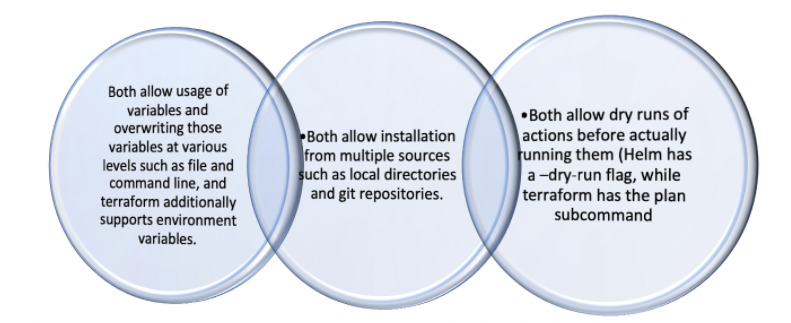Terraform is an open-source Infrastructure as Code (IaC) tool that allows teams to manage and automate infrastructure, platforms, and services. The tool helps build, change, and version infrastructure through code, allowing engineers to quickly and easily:
Helm is a Kubernetes package manager ideal for deploying repeatable apps and services to clusters. This tool allows users to manage ap ps via Helm Charts that simplify defining, installing, and upgrading K8s environments.
Helm Charts are packages of files and templates that convert into Kubernetes manifest files.
A chart is reusable and can contain YAML-based templates of:

Key Features
Terraform uses the cloud provider’s API, making the whole process a lot smoother and more effective in terms of maintainability, ease, and security.
Stability and efficiency through immutable infrastructureForget about configuration drift and bugs. Terraform uses the inflexible infrastructure approach, where servers are replaced rather than changed. This means simplified operations, fewer failures, and fewer errors, threats, and vulnerabilities.
Simplicity through codeWith server provisioning, Terraform leaves issues about software container deployment to Docker. The cloud infrastructure is seen as code, bringing additional advantages.
Effectiveness through declarative code styleWith a declarative code style (imperative programming: how you do something, declarative programming: what you do/what the end state should be), meaning advantages when it comes to brevity, speed, and fewer complications.
Terraform works with any cloud-based setup, so it doesn’t matter if it’s a public cloud or an on-premise-based arrangement.
Helm Charts provide the ability to leverage Kubernetes packages when building and deploying applications through a click or single CLI command. When a user executes the Helm install base, a Tiller (yes, another maritime reference) Server receives the incoming request, installing the appropriate package into the Kubernetes cluster. These packages are called Charts.
A chart can have deployments, config maps, services, and so on defined as YAML files, which are templates. You can define certain charts as dependencies for other charts or nest charts inside others.
Terraform does not install anything within the Kubernetes cluster itself, while Helm installs Tiller within the cluster. Helm cannot install a Kubernetes cluster, while Terraform can. When it comes to modularity, Terraform uses modules while Helm uses sub-charts, and Terraform uses the JSON/HCL file format while Helm uses standard manifests and Go-templates.
Both Terraform and Helm have their advantages and disadvantages. For example, because Terraform uses the same tool and codebase for both infrastructure and cluster management, there is not too much of a learning curve when it comes to using it with Kubernetes. Terraform is also relatively new with its Kubernetes interfacing, so there are some kinks and issues. On the other hand, rolling back with Helm is a lot easier, but maintaining it can take up precious resources.
SIMILARITIES:

The Conclusion
Helm has two parts to it
•The client (CLI), who lives on your local workstation.
•The server (Tiller), which lives on the Kubernetes cluster to executes what’s needed.
The idea is that you use the CLI to push the resources you need, and tiller will make sure that state is in fact, the case by creating/updating/deleting resources from the chart. To fully grasp Helm, there are three concepts we need to get familiar with:
•Chart: A package of pre-configured Kubernetes resources.
•Release: A specific instance of a chart that has been deployed to the cluster using Helm.
•Repository: A group of published charts that can be made available to others
Hence there are certain benefits associated with Helm. In summary, the following can be mentioned as benefits of Helm:
•Boosts productivity
•Reduces duplication & complexity
•Smooths the K8S learning curve
•Simplifies deployments
